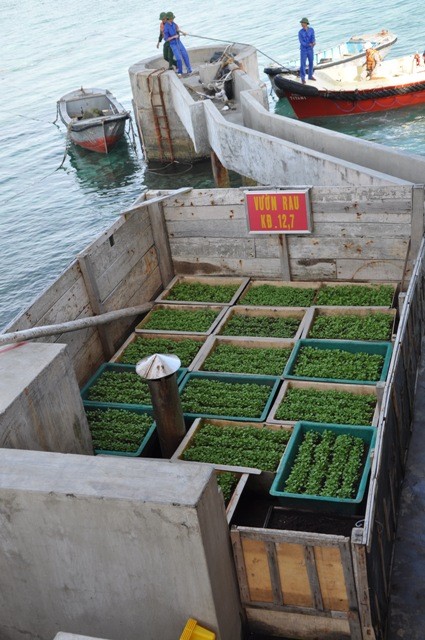(VOVworld) - The harsh climate and lack of fresh water make farming and ranching on the Truong Sa archipelago very difficult. But thanks to the tireless efforts of the islanders and soldiers stationed on the island, there are vegetable gardens almost everywhere and livestock production adds egges and meat to soldiers’ daily meals.
"Small and medium-sized farms," is a term used by journalists to describe the gardens on the Truong Sa archipelago. Vegetables are grown everywhere: in small gardens, and in vases and trays. On submerged islands, vegetables are grown beside the office on the balcony. The soil and the plant varieties come from the mainland. As for the livestock, they can be poultry, pigs, cattle or rabbits. Previously, the lack of fresh water, soil and fertilizer, made vegetable growing virtually impossible, especially on the submerged islands. Today, more frequent visits from the mainland have radically changed the situation. Colonel Nguyen Duc Du, is Deputy Head of Sinh Ton Dong island. He says:"The soldiers are very interested in growing vegetables and livestock production. We have brought to the island several types of vegetables, but the work is not easy. The soil also comes from the mainland. We use fallen leaves to make fertilizer. We now have enough vegetables for our daily meals. "
 |
A campaign has been launched to encourage soldiers and islanders to grow vegetables and raise poultry and animals on the islands. We are very surprised to see vegetable fields on the larger islands such as Truong Sa Lon, Song Tu Tay, or Nam Yet. There are all kinds of vegetables: spinach, water spinach, cabbage, lettuce and herbs, as well as fruits like bananas and papayas. Even on smaller islands like Da Lat, Da Tay and Tien Nu, the soldiers take advantage of every bit of space to grow vegetables. Colonel Hoang Van Vinh, who is in charge of logistics services on Truong Sa Dong island, says that growing vegetables becomes more difficult during the monsoon season: "During the monsoon season, the vegetables must be covered with nylon, otherwise, they are not able to withstand the high winds. We now have 120 trays of soil for growing vegetables. It is more convenient, easy to move, and it saves water. With this type of cultivation, we can eat vegetables every day. We have also made wood frames and put soil in them to grow vegetables".
On larger islands such as Truong Sa Lon, Truong Sa Dong and An Bang, livestock thrives. Arriving on the island, we are instantly made to feel at home by the sight of ducks and chickens foraging for food in the shade of trees – a typical image of the Vietnamese countryside. Each area is carefully covered to withstand the strong wind. Colonel Hoang Van Vinh says that last year Truong Sa Dong island produced 6.5 tons of vegetables and 1.6 tons of meat: "We try to take advantage of local resources. The duck eggs are hatched by chickens, for example. We also get nearly hatched eggs from the mainland and use light bulbs to hatch them. It's effective and disease free! Last year, we hatched to 300 ducks."
The soldiers have even created their own incubator to hatch eggs, and applied new farming techniques. Colonel Nguyen Duc Du says:“On the island, we apply new techniques of the new rural development program in raising chickens, ducks and we cross-breed ducks and muscovy ducks to create stronger breeds. We now have sufficient flocks of birds to ensure a meat supply for soldiers”.
"A hungry man is an angry man," Jacques Diouf, Head of the UN Food and Agriculture Organization has said. Balanced meals allow our soldiers to stay healthy, so they can fulfill their duty of defending Vietnam national sovereignty.